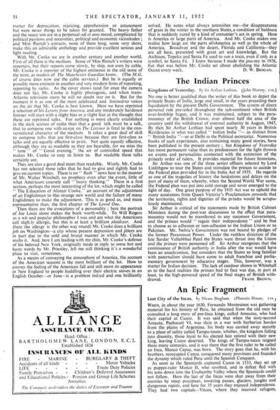An Epic Fragment
Lost City of the Incas. by Hiram Bingham. (Phoenix House. 2 is.) WHEN, in about the year 1630, Fernando Montesinos was gathering material for his history of Peru, he obtained from the old men he consulted a long story of pre-Inca kings, called Amautas, who had their capital at. Cuzco. It was said that when the sixty-second Amauta, Pachacuti VI, was slain in a war with barbarian hordes from the plains of Argentina, his body was carried away secretly to a place of safety called Tampu-tocco, whither, the kingdom falling into disunity, those loyal to his elected heir retired with their new king, leaving Cuzco deserted. The kings of Tampu-tocco reigned there many centuries, and it was there that the first ruler to be called an Inca, Manco Capac, was born. The story goes that he, with his brothers, reoccupied Cuzco, conquered many provinces and founded the dynasty which ruled Peru until the Spanish Conquest.
As soon as the Spaniards captured Cuzco in 1533, they set up as puppet-ruler Manco II, who revolted, and in defeat fled with his sons down into the Urubamba Valley where the Spaniards could not follow. Here the last of the Incas were shut away from their enemies by steep precipices, towering passes, glaciers, jungles and dangerous rapids, and here for 35 years they enjoyed independence. They had two capitals—Vitcos, where they received refugees, emissaries and missionaries, and Vilcapampa. Vitcos was aban- doned after the death of the last Inca in 1571, and Vilcapampa, whose existence was unknown to the Spaniards, was completely lost for three centuries until its discovery—as " Machu Picchu "—by the author of this book and his companions. Mr. Bingham argues cogently that Machu Picchu, or Vilcapampa the Old, is in fact identical with the ancient Tampu-tocco. There is at least poetic significance in his conviction that the birth-place of the Inca dynasty should have been also its final haven.
Mr. Bingham's main expedition in search of the lost capital was made in 1911. After a journey which meant cutting through dense underbrush, climbing the sides of precipices on hands and knees and crossing icy torrents where a slip meant certain death, the explorers found themselves in a region between the Apurimac and Urubamba rivers which-1,500 square miles in extent—was un- marked on any map, and whose very existence had been unsuspected until their entry. In the roughest corner of this inaccessible region they found the object of their search, a stone-built city of sur- prising beauty, with agricultural terraces, burial grounds and two temples, one of which is claimed to be unsurpassed by any in Peru. The city itself was somewhat bare of artifacts, but in the burial caves cooking pots, food vessels and some personal ornaments were found. The remains of 173 individuals were disinterred, of whom some 150 were women—a fact leading to the plausible conclusion that the last residents of Machu Picchu were the " Virgins of the Sun "or Chosen Women who lived in sanctuaries scattered through- out the Inca Empire, and whose lives were consecrated to the service of the kings and priests.
Although the story Mr. Bingham has to tell is of great intrinsic interest, he does not pretend to imaginative insight or literary attistry, and one could wish, ungratefully enough, that his material had fallen into hands more capable of exploiting its potentialities. Even so, it is impossible to read his narrative without being stirred and disquieted by the epic story upon which it throws its own arresting flicker of light. The book is pleasingly produced, and there are 66 pages of fair to medium photographs. D. S. SAVAGE.



































 Previous page
Previous page